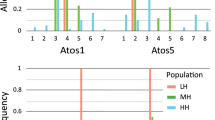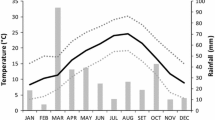Abstract
Dispersal and gene flow of pesticide resistance traits in phytoseiid and tetranychid mites are discussed relative to their biologies and resistance management. The focus is on deciduous fruit-tree crops whereTyphlodromus pyri Scheuten andMetaseiulus occidentalis (Nesbitt) can effectively control spider mite pests. Oregon populations ofM. occidentalis were more dispersive thanT. pyri, as evidenced by movement to small apple trees placed inside and outside of commercial apple orchards. This difference was corroborated by the spatial distributions of organophosphate resistance in populations from sprayed orchards and nearby unsprayed habitats:T. pyri showed patchy, local patterns of resistance whileM. occidentalis showed more regional, homogeneous trends. Gene flow among populations was estimated from allozymic variation ofT. pyri. Intra- and inter-population genetic variation was high enough to prevent population differentiation. Thus, allozymic estimates of gene flow were higher than that indicated by pesticide resistance patterns.
Dispersal inTetranychus urticae Koch is also discussed relative to resistance evolution. Immigration of resistant phenotypes from crops or other sprayed habitats can increase the frequency of resistance. Immigration of susceptible individuals from surrounding unsprayed habitat into a sprayed crop can slow resistance or lead to its reversion, depending on the level of gene flow between populations. Dispersal within crops can have the same effect if susceptibles come from a refuge. In pears, immigration of susceptibleT. urticae from nearby habitat and groundcover aided in reversion of organotin resistance. Experiments on resistance management tactics forT. urticae are discussed.
Similar content being viewed by others
References
Bernstein, C., 1983. Some aspects ofPhytoseiulus persimilis (Acarina: Phytoseiidae) dispersal behaviour. Entomophaga, 28: 185–198.
Bernstein, C., 1984. Prey and predator emigration responses in the acarine systemTetranychus urticae-Phytoseiulus persimilis. Oecologia, 61: 134–142.
Boller, E.F., Remond, U. and Candolfi, M.P., 1988. Hedges as potential sources ofTyphlodromus pyri, the most important predatory mite in vineyards in Northern Switzerland. Entomophaga, 33: 249–255.
Brandenburg, R.L. and Kennedy, G.G., 1982. Intercrop relationships and spider mite dispersal in a corn/peanut agroecosystem. Entomol. Exp. Appl., 32: 269–276.
Croft, B.A., 1990. Arthropod Biological Control Agents and Pesticides. John Wiley, New York, NY.
Croft, B.A., 1992. IPM systems that conserve pesticides, pest-resistant plants and biological control agents, including genetically improved forms. S. Afr. J. Sci. (in press).
Croft, B.A. and Dunley, J.E., 1992. Habitat patterns and pesticide resistance. In: K.C. Kim and B.A. McPheron (Editors), Evolution in Insect Pests: The Pattern of Variation. John Wiley, New York, NY (in press).
Croft, B.A. and van de Baan, H.E., 1988. Ecological and genetic factors influencing evolution of pesticide resistance in tetranychid and phytoseiid mites. Exp. Appl. Acarol., 4: 277–300.
Croft, B.A., Brown, A.W.A. and Hoying, S.A., 1976. Organophosphorous resistance and its inheritance in the predaceous miteAmblyseius fallacis. J. Econ. Entomol., 69: 64–68.
Croft, B.A., Burts, E.C., van de Baan, H.E., Westigard, P.H. and Riedl, H., 1989. Local and regional resistance to fenvalerate inPsylla pyricola Foerster (Homoptera: Psyllidae) in western North America. Can. Entomol., 121: 121–129.
Croft, B.A., Shearer, P.W., Fields, G.J. and Riedl, H., 1990. Distribution ofMetaseiulus occidentalis (Nesbitt) andTyphlodromus pyri Scheuten (Parasitiformes: Phytoseiidae) in apple orchards of the Hood River Valley, Oregon. Can. Entomol., 122: 5–14.
Daly, J.C., 1989. The use of electrophoretic data in the study of gene flow in the pest speciesHeliothis armigera (Hubner) andH. punctigera Wallgren (Lepidoptera: Noctuidae). In: H.D. Loxdale and J. Den Hollander (Editors), Electrophoretic Studies on Agricultural Pests. Clarendon Press, Oxford, pp. 115–142.
De Boer, R., 1985. Reproductive barriers. In: W. Helle and M.W. Sabelis (Editors), Spider Mites: Their Biology, Natural Enemies and Control, Vol. 1A. Elsevier, Amsterdam, pp. 193–199.
Dennehy, T.J., Grafton-Cardwell, E.E., Granett, J. and Barbour, K., 1987. Practitioner-assessab bioassay for detection of dicofol resistance in spider mites (Acari: Tetranychidae). J. Econ. Entomol., 80: 998–1003.
Dunley, J.E. and Croft, B.A., 1990. Dispersal between and colonization of apple byMetaseiulus occidentalis andTyphlodromus pyri (Acarina: Phytoseiidae). Exp. Appl. Acarol., 10: 137–149.
Dunley, J.E. and Croft, B.A., 1992a. Spatial distribution of organophosphate resistance inTyphlodromus pyri andMetaseiulus occidentalis in the Hood River and Willamette Valleys of Oregon. J. Econ. Entomol. (in review).
Dunley, J.E. and Croft, B.A., 1992b. Allozymic variation and gene flow of organophosphate resistance inTyphlodromus pyri in the Hood River and Willamette Valleys of Oregon. J. Econ. Entomol. (in review).
Falconer, D.S., 1989. Introduction to Quantitative Genetics, 3rd ed. Longman, New York, NY.
Flexner, J.L., Westigard, P.H. and Croft, B.A., 1988. Field reversion of organotin resistance in the two-spotted spider mite (Acari: Tetranychidae) following relaxation of selection pressure. J. Econ. Entomol., 81: 1516–1520.
Flexner, J.L., Theiling, K.M., Croft, B.A. and Westigard, P.H., 1989. Fitness and immigration: Factors affecting reversion of organotin resistance in the twospotted spider mite (Acari: Tetranychidae). J. Econ. Entomol., 82: 966–1002.
Flexner, J.L., Westigard, P.H., Gonzalves, P. and Hilton, R., 1991. The effect of groundcover and herbicide on twospotted spider mite density and dispersal in Southern Oregon pear orchards. Entomol. Exp. Appl., 60: 111–123.
Flexner, J.L., Westigard, P.H., Hilton, R. and Croft, B.A., 1992. Experimental evaluation of resistance management strategies for twospotted spider mite (Acari: Tetranychidae) on Southern Oregon pear. J. Econ. Entomol. (in press).
Follett, P.A., Croft, B.A. and Westigard, P.H., 1985. Regional resistance to insecticides inPsylla pyricola from pear orchards in Oregon. Can. Entomol., 117: 565–573.
Genini, M. and Baillod, M., 1987. Introduction de souches resistantes deTyphlodromus pyri (Scheuten) etAmblyseius andersoni Chant (Acari: Phytoseiidae) en vergers de pommiers. Rev. Suisse Vitic. Arboric. Hortic., 19: 115–128.
Grafton-Cardwell, E.E., Granett, J. and Normington, S.M., 1991. Influence of dispersal from almonds on the population dynamics and acaricide resistance frequencies of spider mites infesting neighboring cotton. Exp. Appl. Acarol., 10: 187–212.
Helle, W. and Sabelis, M.W., 1985. Spider Mites: Their Biology, Natural Enemies and Control, Vol 1B. Elsevier, Amsterdam, 458 pp.
Hoy, M.A., 1985. Recent advances in the genetics and genetic improvement of the Phytoseiidae. Annu. Rev. Entomol., 30: 345–370.
Hoy, M.A., Groot, J.J.R. and van de Baan, H.E., 1985. Influence of aerial dispersal on persistence and spread of pesticide-resistantMetaseiulus occidentalis in California almond orchards. Entomol. Exp. Appl., 37: 17–31.
Hoyt, S.C., Westigard, P.H. and Croft, B.A., 1985. Cyhexatin resistance in Oregon populations ofTetranychus urticae. J. Econ. Entomol., 78: 656–659.
Hussey, N.W. and Parr, W.J., 1963. Dispersal of the glasshouse red spider miteTetranychus urticae Koch (Acarina: Tetranychidae). Entomol. Exp. Appl., 6: 207–214.
Kennedy, G.G. and Margolies, D.C., 1985. The twospotted spider mite: a case history. In: D.R. MacKenzie, C.S. Barfield, G.G. Kennedy and R.D. Berger (Editors), The Movement and Dispersal of Agriculturally Important Biotic Agents. Claitor, Baton Rouge, LA, pp. 443–452.
Kennedy, G.G. and Smitley, D. R., 1985. Dispersal. In: W. Helle and M.W. Sabelis (Editors) Vol 1A. Spider Mites: Their Biology, Natural Enemies and Control. Elsevier, Amsterdam, pp. 233–242.
Miller, R.W., Croft, B.A. and Nelson, R.D., 1985. Effects of early season immigration on cyhexatin and formetanate resistance ofTetranychus urticae (Acarina: Tetranychidae) on strawberries in Central California. J. Econ. Entomol., 78: 1379–1388.
Sabelis, M.W. and Dicke, M., 1985. Long-range dispersal and searching behaviour. In: W. Helle and M.W. Sabelis (Editors), Spider Mites: Their Biology, Natural Enemies and Control, Vol 1B. Elsevier, Amsterdam, pp. 141–160.
Sites, R.W. and Cone, W.W., 1985. Vertical dispersion of twospotted spider mites on hops throughout the growing season. J. Entomol. Soc. B.C., 82: 22–25.
Smitley, D.R. and Kennedy, G.G., 1985. Photo-oriented aerial-dispersal behavior ofTetranychus urticae (Acari: Tetranychidae) enhances escape from the leaf surface. Ann. Entomol. Soc. Am., 78: 609–614.
Sula, B. and Weyda, F., 1983. Esterase polymorphism in several populations of the two-spotted spider miteTetranychus urticae Koch. Experientia, 39: 78–79.
Workman, P.L. and Niswander, J.D., 1970. Population studies on southwestern Indian tribes. II. Local genetic differentiation in the Papago. Am. J. Human Genet., 22: 24–29.
Wright, S., 1978. Evolution and Genetics of Populations. Vol 4. Variability Within and Among Natural Populations. Univ. of Chicago Press, Chicago, IL, 580 pp.
Author information
Authors and Affiliations
Rights and permissions
About this article
Cite this article
Dunley, J.E., Croft, B.A. Dispersal and gene flow of pesticide resistance traits in phytoseiid and tetranychid mites. Exp Appl Acarol 14, 313–325 (1992). https://doi.org/10.1007/BF01200570
Issue Date:
DOI: https://doi.org/10.1007/BF01200570




